Related Research Articles
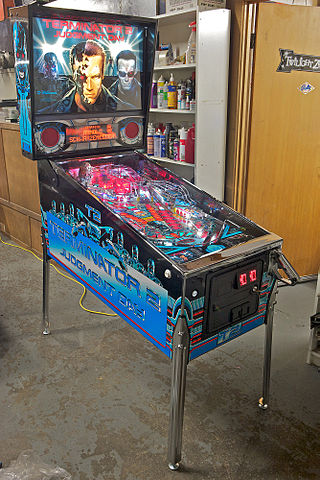
Pinball games are a family of games in which a ball is propelled into a specially designed table where it bounces off various obstacles, scoring points either en route or when it comes to rest. Historically the board was studded with nails called 'pins' and had hollows or pockets which scored points if the ball came to rest in them. Today, pinball is most commonly an arcade game in which the ball is fired into a specially designed cabinet known as a pinball machine, hitting various lights, bumpers, ramps, and other targets depending on its design.

MAME is a free and open-source emulator designed to recreate the hardware of arcade games, video game consoles, old computers and other systems in software on modern personal computers and other platforms. Its intention is to preserve gaming history by preventing vintage video games from being lost or forgotten. It does this by emulating the inner workings of the emulated machines; the ability to actually play the video games is considered "a nice side effect". Joystiq has listed MAME as an application that every Windows and Mac gamer should have.
A game engine is a software framework primarily designed for the development of video games and generally includes relevant libraries and support programs such as a level editor. The "engine" terminology is akin to the term "software engine" used more widely in the software industry.
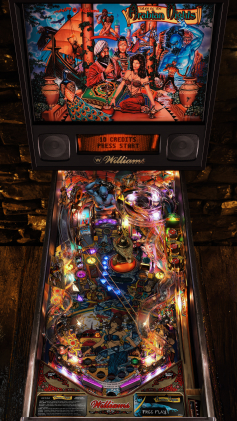
Visual Pinball ("VP") is a freeware and source available video game engine for pinball tables and similar games such as pachinko machines. It includes a table editor as well as the simulator itself, and runs on Microsoft Windows. It can be used with Visual PinMAME, an emulator for ROM images from real pinball machines.
Lingo is a verbose object-oriented (OO) scripting language developed by John H. Thompson for use in Adobe Director. Lingo is used to develop desktop application software, interactive kiosks, CD-ROMs and Adobe Shockwave content.

Full Tilt! Pinball, known as Pinball 95 in Europe, is a 1995 pinball video game developed by Cinematronics and published by Maxis. It features pre-rendered 3D graphics and three tables: Space Cadet, Skulduggery, and Dragon's Keep. A sequel called Full Tilt! Pinball 2 was released in 1996.

Galactic Pinball is a 1995 pinball video game developed by Intelligent Systems and published by Nintendo for the Virtual Boy. The game was released on July 21, 1995 in Japan and on August 14, 1995 in the United States. It is set in the Milky Way galaxy, and has players maneuvering a puck around one of four pinball tables available in the game. The Virtual Boy's standard red-and-black color scheme resulted in criticism of this and other games on the platform for causing nausea, headaches, and eye strain. It uses parallax, which allows the game to display three-dimensional effects. It has received a mixed reception; it was praised for its authenticity, while reception to its physics and controls were mixed. It has received criticism for its lack of ambition and originality.
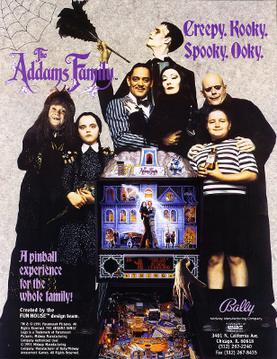
The Addams Family is a pinball machine released in March 1992. It was designed by Pat Lawlor and Larry DeMar and released by Midway. It was based on the 1991 film of the same name, and features custom speech by the stars of the film, Anjelica Huston and Raul Julia. It is the best-selling solid state pinball machine of all time with 20,270 units sold.

Black Hole is a pinball game released in 1981 by Gottlieb. It is notable for having two playfields: one on top with a conventional slope, and one mounted underneath, sloping away from the player. It has no connection with the 1979 film of the same name.
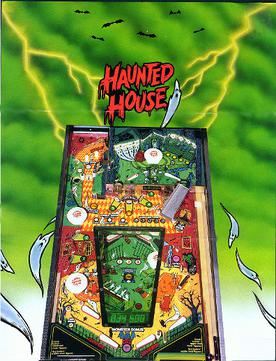
Haunted House is a pinball game released in October 31 1982 by Gottlieb. It was the first game with three playfields that the ball can move between, including one below the main playing surface. Haunted House was designed by John Osborne, with artwork by Terry Doerzaph. It is part of Gottlieb’s “System 80” series of pinball machines.
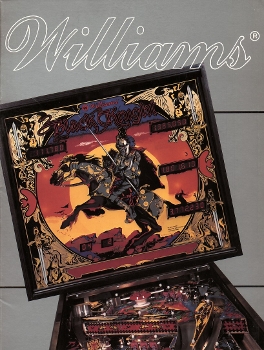
Black Knight is a 1980 pinball machine designed by Steve Ritchie and released by Williams Electronics. Ritchie designed two sequels: Black Knight 2000, released by Williams in 1989, and Black Knight: Sword of Rage, released by Stern Pinball in 2019.

Obsession is a pinball video game developed and originally published by Unique Development Sweden for the Atari STe on December 2, 1994. It is the first video game to be created by UDS and one of the last official releases for the Atari ST platform after being discontinued in 1993 by Atari Corporation. In the game, players can choose between any of the four available playfields, both of which have their own thematic and main objectives in order to obtain the highest score possible.
UltraPin is a Multi-Game pinball arcade game that holds 12 digital recreations of Williams Electronics real pinball games in a single pinball cabinet. UltraPin is built in a traditional style pinball cabinet to look and feel like a real pinball machine. It has two LCD screens, a 19 inch LCD for the back glass and DMD, and a 32 inch LCD for the playfield, and it uses Windows XP Embedded for its operating system.

Zen Pinball is a series of pinball machine video games developed and published by Zen Studios. It was originally released on iOS as two separate applications, each containing one table; Zen Pinball: Rollercoaster, released July 7, 2008, and Zen Pinball: Inferno, released October 31, 2008. Zen Pinball for the PlayStation 3 features four tables, plus an additional six tables as downloadable content. It was released on the PlayStation Network on May 14, 2009. It is the non-Microsoft counterpart to the Pinball FX series on the Xbox 360, and the first pinball game on the PlayStation 3. The game was also released on Android devices as Zen Pinball THD on December 1, 2011, and the Nintendo 3DS as Zen Pinball 3D via the Nintendo eShop on December 1, 2011 in Europe and January 12, 2012 in North America.

Video Pinball is a video game programmed by Bob Smith and released by Atari, Inc. in 1980 for the Atari VCS. The Sears rebranded version for its Tele-Games system is Arcade Pinball.

Pinball FX 2 is a pinball video game for Xbox 360, Xbox One, and Microsoft Windows and is the sequel to Pinball FX. It was developed by Zen Studios and published by Microsoft Studios. It was released on October 27, 2010, via the Xbox Live Arcade service. The game includes several new features, such as local multiplayer and the ability to tweak table settings. Players can also import all of the tables from Pinball FX they had previously purchased. The Windows 8 version of Pinball FX 2 was released on the Windows Store on October 27, 2012, two years after the original XBLA release. The game was subsequently released for other Windows platforms via Steam on May 10, 2013. Pinball FX 2 was announced for Windows Phone in February 2012. A sequel, Pinball FX 3 was released in September 2017.

The Party Zone is a crossover solid-state pinball machine released in 1991 by Midway designed by Dennis Nordman and programmed by Jim Strompolis. It is in a single playfield format and collaborates characters from previous pinball machines. It is the second pinball machine released after the Bally-Midway division was sold, yet still operated under the "Bally" name.

Flight 2000 is a 1980 Stern widebody pinball machine. It was the first table by this company with speech. The theme of the game revolves around futuristic space flight.

Sorcerer is a 1985 pinball machine designed by Mark Ritchie and released by Williams Electronics. The table is placed in the "Internet Pinball Data Base Top 100 Rated Electronic Pinball Machines" chart.

Rescue 911 is a pinball machine designed by Bill Parker and released by Gottlieb in 1994. The game is based on the TV show of the same name.
References
- ↑ Future Pinball — freewaregenius.com
- ↑ The Future of Pinball from popbumper.com
- ↑ "The Virtual Pinball Forums".
- ↑ Future of Pinball on mobygames
- ↑ Future Pinball tutorials
- ↑ c't, 12/2012, page 150.
- ↑ PN's Resources / Future Pinball / FP Support Files section